IB_chapter3_International trade theory and political reality
3-Modern international trade theory
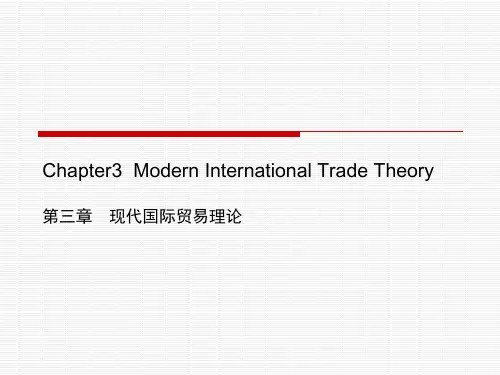
Making a study on manufacturer behavior is to introduce the characteristics of the social economy, and have a better understanding of inter-state trade. So we make the following assumptions for the economic social operation: 研究厂商行为是为了推出社会经济运行的特征,更好地理解国与国间的贸易,对经济社会运行作如下假 设: First, the economy society makes two production factors (capital and labor) to produce two goods X and Y; 第一,经济社会使用两种生产要素(资本和劳动)生产两种商品X和Y;
The two production of A country
A国两种商品的生产
资本(K) K3 EY Y3=3Y1 资本和劳动的价格w和r不变 K2 Y2=2Y1 Y1 K1 X3=3X1 L1 X1 X2=2X1 L3 L2 EX
O
劳动(L)
A country has a larger amount of labor than capital, and the country use all of the capital and labor to produce two goods X and Y, and the two sectors are constant returns to scale. The slope of expansion channel OEX of X industry in A country is smaller than the channel OEY of Y industry, X industry (K / L) X is less than the Y industry (K / L) Y, It is said X in country A is labor-intensive industry, and Y industry is capitalintensive industry. A国劳动拥有量大于资本,使用所有的资本和劳动生产两种商品 X和Y, 两个行业都是规模报酬不变。A国X行业的扩张通道OEX的斜率比Y行 业的扩张通道OEY小,X行业(K/L)X小于Y行业(K/L)Y,称在A 国X行业是劳动密集型行业,Y行业是资本密集型行业。
theoryofinternationaltrade国际贸易理论
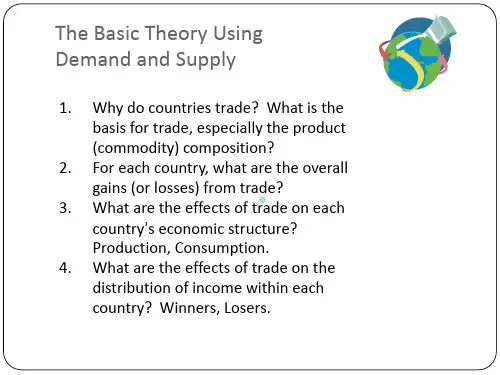
1. Why do countries trade? What is the basis for trade, especially the product (commodity) composition?
2. For each country, what are the overall gains (or losses) from trade?
3. What are the effects of trade on each country’s economic structure? Production, Consumption.
4. What are the effects of trade on the distribution of income within each country? Winners, Losers.
Thus the producer surplus is equal to
P S(ez)ze
The Rising Importance of Trade
Trade flows relative to GDP have increased sharply
A National Market with No Trade
The Demand and Supply of Motorbikes
Demand--Preliminaries
•Demand curve shows the maximum price buyers are willing to pay for each unit. •Demand versus “quantity-demanded.” •“Law of demand” and the “substitution effect.” •Change (shift) of demand. •Elasticity—a measure of the responsiveness of quantity-demanded to a change in market price.
Internationaltradechapter3part1PPT课件
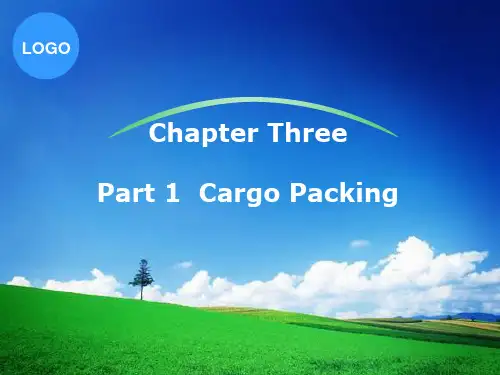
Company Logo
Shipping Marks
Including information:
▪ Name of exporter and his address ▪ Name of importer ▪ Contract number ▪ Carton or crate number (piece number, serial
运输包装和销售包装
Company Logo
❖Bulk Cargo , Nude Cargo and Packed Cargo
❖ Bulk Cargo / Cargo in Bulk grain, ore, coal and sand ❖ Nude Cargo steel product, timber, tyre and cars ❖ Packed Cargo most of commodities
Company Logo
❖ Container 20foot 40foot TEU (Twenty-foot Equivalent Unit)
Company Logo
Company Logo
Company Logo
钢制托盘
塑料托盘
Company Logo
forklift
Company Logo
LOGO
Chapter Three Part 1 Cargo Packing
Sales contract
❖ Name and quality clause ❖ Quantity clause ❖ Packing clause ❖ Price clause ❖ Transport clause ❖ Payment clause ❖ Insurance clause ❖ Inspection clause ❖ Arbitration clause ❖ Claim clause ❖ Force Majeure clause
第三章 国际贸易理论框架.ppt
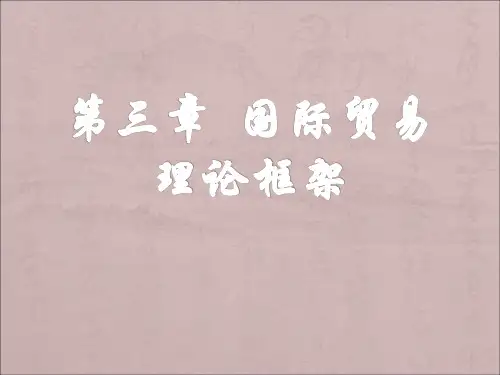
+ 规模经济理论 + 产业内贸易理论 + 技术差距理论
+
产品生命周期学 说
+ 需求相似理论
+ 一、古典国际贸易理论
+ 1、亚当·斯密的绝对成本理论
时期:(18世纪60年代到19世纪60年代) 背景:是在亚当所处的时代,英国的产业革命逐渐
展开,经济实力不断增强,新兴的产业资产阶级迫 切要求在国民(经济)各个领域中迅速发展资本主 义。
1873年)
+ 代表作《政治经济学》
+ 约翰.斯图亚特·穆勒(John Stuart Mi11 1806-1873) 是英国实证主义的最早代表,也是19世纪英国影响 最大的思想家之一。
+ 他出生于伦敦一个学者家庭。其父詹姆士·穆勒 (1773-1836)是19世纪英国休谟派哲学家、著名功 利主义者边沁的门人,在哲学、政治经济学、历史、 伦理等方面均有较高造诣。约翰·穆勒没有进过正规 学校,主要是在其父的指导和熏陶下自学。。1820 年,他到了法国,不仅学习法国语言文学,也学化 学、动物学、逻辑学和高等数学,并结识了一些自 由派经济学家和思想家。穆勒1823年随父到英国东 印度公司任秘书,直到1858年此公司解散为止,最 后两年曾任高级职务。穆勒没有在大学里任过教, 除公司事务外,其余时间主要是从事著述。1865一 1868年,他任英国国会下院议员,接近自由党。穆 勒在哲学、政治、经济、宗教、道德等各方面都有 著述,其主要哲学著作有:《逻辑体系》(1843)、 《论自由》(1859)、《功利主义》(1861)、 《汉弥尔顿爵士哲学研究》(1860、《孔德和实证 主义》(1865)、《论宗教》(1874)等。
1-International trade theory
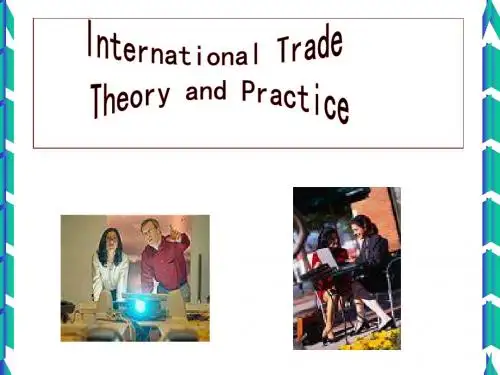
•
Trade will benefit both nations provided only that their relative costs are different for two or more commodities. In short, trade depends on differences in comparative cost, and one nation can profitably trade with another even though its real costs are higher in every commodity.
REASONS FOR INTERNATIONAL TRADE
1) Resource reasons
The uneven distribution of resources around the world is one of the basic reasons why nations began and continue to trade with each other. (1) Favorable climatic conditions and terrain
Leading exporters in world merchandise trade (year:2006 Unit: billion dollars)
1 2 3 4 5 6 7 8 9 10 Germany America China Japan France Netherlands United Kingdom Italy Canada Belgium 1111.2 1038.3 968.9 649.9 490.4 462.4 448.3 410.6 389.5 369.2
Chapter-International-Trade-Theory文档
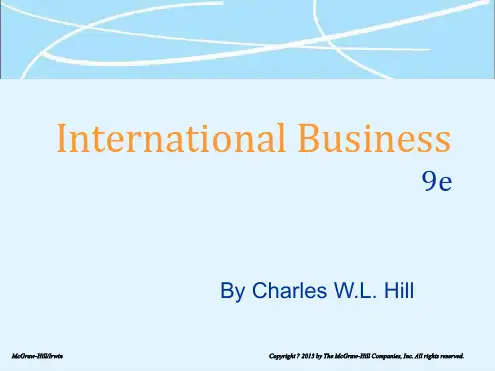
?New trade theory and Porter's theory of national competitive advantage justify limited and selective government intervention to support the development of certain export-oriented industries
?South Korea could produce 5 tons of cocoa and no rice, 20 tons of rice and no cocoa, or some combination in between
6-10
How Does The Theory Of Absolute Advantage Work?
?advocates government intervention to achieve a surplus in the balance of trade
?Mercantilism views trade as a zero-sum game - one in which a gain by one country results in a loss by another
?International trade allows a country
?to specialize in the manufacture and export of products and services that it can produce efficiently
国际贸易学课件--International Trade Theory
代表人物:托马斯·孟(Thomas Mun, 1571-
1641)
2020/9/30
Copyright by 钱学锋
博弈论(Game theory)
一、田忌赛马、斗地主与《美丽心灵》
来,斗两把!
二、博弈模型的构成 ►博弈方(Players) ►策略(Strategies) ► 次序(Orders) ► 得益(Payoffs)
假设两个国家是“中国”和“美国”。两国 都生产“大米”和“小麦”,但生产技术不同。 劳动是唯一的生产要素,两国有相同的劳动力资 源,都是100 人。
2020/9/30
Copyright by 钱学锋
表2-1:中国和美国的生产可能性
表2-2:中国和美国的劳动生产率
2020/9/30
Copyright by 钱学锋
Chapter 2: International Trade Theory
一、古典贸易理论(Classical Trade Theory) 二、新古典贸易理论(Neo-Classical Trade Theory ) 三、新贸易理论(New Trade Theory) 四、新新贸易理论(New New Trade Theory)
“劳动生产力上最大的增进、以及运用劳动时所 表现的更大的熟练、技巧和判断力、似乎都是分 工的结果。”
2020/9/30
Copyright by 钱学锋
分工的好处:
1、劳动者的技巧因业专而日进; 2、可以免除因工作转换而损失的时间; 3、有利于机械的发明。
男女搭配, 工作不累!
2020/9/30
Copyright by 钱学锋
绝对优势理论的意义和局限性
internationaltrade (3)
International TradeIntroductionInternational trade refers to the exchange of goods, services, and capital between countries. It plays a significant role in promoting economic growth, improving living standards, and fostering global integration. This document aims to explore the concept of international trade, its benefits, challenges, and key considerations.Benefits of International TradeEconomic GrowthOne of the key benefits of international trade is the stimulation of economic growth. By participating in global markets, countries can tap into a wider customer base, leading to increased production and higher revenue for businesses. This, in turn, generates employment opportunities and boosts economic activities.Access to ResourcesInternational trade allows countries to access resources that may be scarce or expensive domestically. For example, some countries may lack the natural resources required for industrial production, such as oil or minerals. Through trade, these resources can be imported, ensuring uninterrupted production and economic development.Specialization and Comparative AdvantageInternational trade encourages countries to specialize in producing goods and services in which they have a comparative advantage. Comparative advantage refers to a country’s ability to produce a specific good or service at a lower opportunity cost compared to other countries. By focusing on producing goods that they can produce more efficiently, countries can maximize their productivity, leading to increased output and overall economic welfare.Consumer BenefitsInternational trade provides consumers with access to a wider range of goods and services at competitive prices. As countries specialize in producing certain goods, they can achieve economies of scale, reducing production costs. This cost reduction is passed on to consumers through lower prices, thus improving their purchasing power and overall standard of living.Challenges in International TradeTrade BarriersTrade barriers, such as tariffs, quotas, and subsidies, can hinder international trade and limit its benefits. Tariffs are taxes imposed on imported goods, making them more expensive and less competitive. Quotas restrict the quantity of goods that can be imported. Subsidies, on the other hand, provide financial assistance to domestic producers, giving them an unfair advantage over international competitors. These barriers can distort market competition, reduce efficiency, and limit consumer choices.Political and Legal ConsiderationsInternational trade is influenced by political and legal factors, such as trade agreements, regulations, and intellectual property rights. Negotiating and complying with these agreements can be complex and time-consuming. Disputes arising from trade disagreements can lead to trade wars and affect the stability of global trade relationships.Currency FluctuationsCurrency fluctuations can impact international trade by affecting the costs of imports and exports. When a country’s currency appreciates, its exports become more expensive, potentially reducing demand. Conversely, a depreciation of the currency can make imports more expensive, leading to inflation and reducing purchasing power. These fluctuations can introduce uncertainty and volatility into international trade transactions.Key Considerations for International TradeMarket Research and AnalysisBefore engaging in international trade, thorough market research and analysis are essential. Understanding the target market, consumer preferences, and competitive landscape can help identify opportunities and risks. This information allows businesses to tailor their products and marketing strategies to meet the specific demands of international customers.Legal and Regulatory ComplianceCompliance with international trade laws and regulations is crucial to ensure smooth operations and avoid legal disputes. Businesses need to be aware of customs regulations, import/export requirements, and trade restrictions imposed by different countries. Engaging legal experts can assist in navigating the complexities of international trade laws.Risk ManagementInternational trade carries inherent risks, such as political instability, economic downturns, and transportation issues. Businesses should develop risk management strategies to mitigate potential risks. This may include diversifying the customer base, securing insurance coverage, and establishing contingency plans for disruptions in the supply chain.Cultural and Language ConsiderationsInternational trade involves interactions with individuals from diverse cultural backgrounds. Understanding cultural nuances and adapting communication strategies accordingly can help build trust and facilitate successful business negotiations. Language barriers can also be overcome through translation services or hiring multilingual staff.ConclusionInternational trade plays a vital role in promoting economic growth, enhancing living standards, and facilitating global integration. By embracing the benefits of international trade, countries can leverage opportunities, access resources, and enjoy a wider array of goods and services. However, challenges such as trade barriers, political considerations, and currency fluctuations exist. Addressing thesechallenges through market research, legal compliance, risk management, and cultural considerations can pave the way for successful international trade partnerships.。
04-International Trade Theory
International Trade TheoryThis chapter has reviewed a number of theories that explain why it is beneficial for a country to engage in international trade and has explained the pattern of international trade that we observe in the world economy. We have seen how the theories of Smith, Ricardo, and Heckscher-Ohlin all make strong cases for unrestricted free trade. In contrast, the mercantilist doctrine and, to a lesser extent, the new trade theory can be interpreted to support government intervention to promote exports through subsidies and to limit imports through tariffs and quotas. In explaining the pattern of international trade, the second objective of this chapter, we have seen that with the exception of mercantilism, which is silent on this issue, the different theories offer largely complementary explanations. Although no one theory may explain the apparent pattern of international trade, taken together, the theory of comparative advantage, the Heckscher-Ohlin theory, the product life-cycle theory, the new trade theory, and Porter's theory of national competitive advantage do suggest which factors are important. Comparative advantage tells us that productivity differences are important; Heckscher-Ohlin tells us that factor endowments matter; the product life-cycle theory tells us that where a new product is introduced is important; the new trade theory tells us that increasing returns to specialization and first-mover advantages matter; and Porter tells us that all these factors may be important insofar as they impact the four components of the national diamond. The following points have been made in this chapter:1.Mercantilists argued that it was in a country's best interests to run a balance-of-tradesurplus. They viewed trade as a zero-sum game, in which one country's gains cause losses for other countries.2.The theory of absolute advantage suggests that countries differ in their ability toproduce goods efficiently. The theory suggests that a country should specialize in producing goods in areas where it has an absolute advantage and import goods in areas where other countries have absolute advantages.3.The theory of comparative advantage suggests that it makes sense for a country tospecialize in producing those goods that it can produce most efficiently, while buying goods that it can produce relatively less efficiently from other countries-even if that means buying goods from other countries that it could produce more efficiently itself.4.The theory of comparative advantage suggests that unrestricted free trade bringsabout increased world production; that is, that trade is a positive-sum game.5.The theory of comparative advantage also suggests that opening a country to freetrade stimulates economic growth, which creates dynamic gains from trade. The empirical evidence seems to be consistent with this claim.6.The Heckscher-Ohlin theory argues that the pattern of international trade isdetermined by differences in factor endowments. It predicts that countries will export those goods that make intensive use of locally abundant factors and will import goods that make intensive use of factors that are locally scarce.7.The product life-cycle theory suggests that trade patterns are influenced by where anew product is introduced. In an increasingly integrated global economy, the productlife-cycle theory seems to be less predictive than it was between 1945 and 1975. 8.The new trade theory argues that in those industries where substantial economies ofscale imply that the world market will profitably support only a few firms, countries may predominate in the export of certain products simply because they had a firm that was a first mover in that industry.9.Some new trade theorists have promoted the idea of strategic trade policy. Theargument is that government, by the sophisticated and judicious use of subsidies, might be able to increase the chances of domestic firms becoming first movers in newly emerging industries.10.Porter's theory of national competitive advantage suggests that the pattern of tradeis influenced by four attributes of a nation: (a) factor endowments, (b) domestic demand conditions, (c) relating and supporting industries, and (d) firm strategy, structure, and rivalry.11.Theories of international trade are important to an individual business firm primarilybecause they can help the firm decide where to locate its various production activities.12.Firms involved in international trade can and do exert a strong influence ongovernment policy toward trade. By lobbying government, business firms can promote free trade or trade restrictions.。
International trade theory-Handout3
ECON G31D Handout 3The Heckscher-Ohlin modelBSS Chapter 5MMKM Chapter 8 and Appendix 3BPS Chapter 6Trade is based on differences in factor endowments. Hence the difference from the ‘no trade’ model is that we drop the assumption of identical relative factor endowments.Based on neoclassical production theory.Countries only differ in terms of their endowments of capital and labour.The main idea is that those countries with relatively abundant capital (typically developed countries) will export capital intensive goods, while those countries with relatively abundant labour (typically developing countries) will export labour intensive goods.Thus trade is based on differences between countries and trade between very similar countries (e.g. within the EU) is not explained by this model. Four main propositions:1.The Heckscher-Ohlin theorem:Each country will export the good which is relatively intensive in that country’s relatively abundant factor.2.The factor price equalisation theorem:Trade equalises the real return to each factor of production acrosscountries.3.The Stolper-Samuelson theorem:Trade increases the real return to a country’s relatively abundant factor but reduces the real return to the relatively scarce factor.4.The Rybczynski theorem:An increase in a country’s endowment of one factor will increase output of the good which uses that factor intensively and reduce output of the other good.Assumptions•There are 2 countries, 2 goods and 2 factors of production.Production•Factors are homogeneous within and between countries.•The supply of each factor in each country is fixed. Factors are perfectly mobile between industries within a country but immobile betweencountries.•Production functions are identical between countries and exhibit constant returns to scale.•Goods differ in their factor requirements, with no factor intensity reversals. Hence we can say that one good is always labour intensive and the other always capital intensive.Demand•Preferences are homothetic and identical between countries.Other assumptions•Both countries produce both goods.•No transport costs, tariffs or other barriers to trade.•All commodity and factor markets are perfectly competitive.•Countries differ in their relative factor endowments.All the assumptions except the final one are made to rule out alternative causes of trade.Hence differences in factor endowments are isolated as the cause of trade. Factor Intensities:We assume that good X is always capital intensive and good Y is always labour intensive.Factor Endowments and PPFsTo see the relationship between endowments and PPFs, consider this diagram:LClearly country A, with relatively more capital, can produce a greater total quantity of X, while country B can produce a greater total quantity of Y.XAutarky equilibriumIn autarky, the relative prices of the two goods differ in the two countries. Specifically, in each country the good which intensively uses that country’s relatively abundant factor is relatively cheap.XFree trade equilibriumResidents of country A will see that Y is relatively cheap in country B. Residents of country B will see that X is relatively cheap in country A. Hence residents of A will start importing Y from B, and residents of B will start importing X from A, until prices are equalised.XEach country now produces more of the good which is intensive in that country’s relatively abundant factor.The previous diagram illustrates the Heckscher-Ohlin Theorem :Given the assumptions of the model, each country will export thecommodity which intensively uses its relatively abundant factor.Differences in the relative supplies of capital and labour are the only reason for trade in this model.In effect, each country exports the services of its relatively abundant factor. Thus trade in goods offsets differences in supplies of factors.Factor returns and endowments (Stolper-Samuelson theorem)In neoclassical production theory, we saw that commodity price changes were associated with greater factor price changes.e.g. if P Y rises and Y is labour-intensive,r P P wX Y ˆˆˆˆ>>>This leads directly to the simple version of the Stolper-Samuelson theorem :A relative increase in the price of a commodity will increase the real return to the factor used intensively in that industry and reduce the real return to the other factor.For each country, trade is associated with a rise in the relative price of that country’s export good.From the HO theorem, we know that each country exports the good which intensively uses its relatively abundant factor.Hence a stronger result arising from the SS theorem is:The real return to a country’s relatively abundant factor rises when a country opens to trade, while the real return to the other factor falls.Factor Price EqualisationWhen looking at neoclassical production, we saw a direct relationship between commodity prices and factor prices.With identical technology, the link between commodity and factor prices must be the same in both countries, so long as both countries produce both goods.Hence as trade equalises commodity prices, it will also equalise factor prices.The Factor price equalisation theorem states:Under the assumptions of the model, free trade in commodities willequalise factor prices, so long as both countries produce both goods. The factor price equalisation theorem can be illustrated diagramatically for arbitrarily chosen factor prices:LGiven these factor prices, efficient production of the two goods requires them to use capital-labour ratios k X and k Y.The area between the rays from the origin showing these capital-labour ratios is called the cone of diversification. If the countries’ endowment points lie within this cone, both countries will produce both goods.Hence if both countries’ endowments lie within the cone of diversification, factor prices will be equalised.When will factor prices not be equalised?1. Tariffs or transport costs generally prevent goods prices from equalising. Factor prices, like goods prices, will tend to converge but not equalise.2. With sufficiently diverse factor endowments, one country might specialise completely. Commodity price equalisation is no longer sufficient for factor price equalisation.(See section on integrated equilibrium approach below.)3. Factor intensity reversals.Even when both countries are diversified, commodity price equalisation might not lead to factor price equalisation with a FIR. The easiest way to see this is with the diagram below, where a single price ratio is consistent with two factor price ratios.K/LWhen will two countries produce both goods with different factor price ratios?We need to return to the idea of the cone of diversification. We saw when looking at neoclassical production that with a FIR, there will be more than one possible equilibrium wage rental ratio for a given pair of isoquants. This also means that there will be two possible cones of diversification.LNow assume that one country has its endowment point in the cone of diversification corresponding to factor price ratio (w/r)1 and the other country has its endowment point in the cone of diversification corresponding to factor price ratio (w/r)2.Both countries will produce both goods, but trade will not equalise factor prices.4. Factor price equalisation depends on the other main assumptions of the model: most importantly identical CRS production functions.5. The number of goods and factors needs to be equal and factors need to be free to move between industries.Integrated Equilibrium approach1Instead of taking two countries’ factor endowments and looking for conditions under which factor prices are equalised, we can think of world endowments of factors and how they can be divided to ensure factor price equalisation.In the diagram below, the axes represent world allocations of capital and labour.Assuming the world economy is integrated (factors are free to move anywhere), we can find equilibrium prices and factor prices. Suppose that at these factor prices Ok X and Ok Y are the equilibrium K-L ratios in the twoAFactor prices will be equalised if the integrated equilibrium can be reproduced under free trade. What division of factor endowments will allow this?Points Q X and Q Y represent the quantities of resources used in producing each good. It can be shown that any division of resources inside the parallelogram O A Q X O B Q Y is consistent with the integrated equilibrium.1 A more formal description of this approach can be found in A.K. Dixit and V. Norman, Theory of International Trade, Cambridge University Press, 1980.Consider point E, which represents the endowments of the two countries measured from their respective origins.Construct the parallelogram O A CED. If O A C = O A Q X/3 and O A D = O A Q Y/2, then country A produces a third of total production of X and half total production of Y, while country B produces the rest.Both countries produce both goods using the same factor proportions, and factor prices are equalised.Now consider country A’s endowment point at Z, outside parallelogramO A Q X O B Q Y. If country A produces the two goods using the integrated equilibrium factor prices, the factors used in producing good X (O X F) will produce enough to exceed world demand. Hence the integrated equilibrium cannot be reproduced.Factor price equalisation is consistent with all points on or inside parallelogram O A Q X O B Q Y:•Inside O A Q X O B Q Y both countries’ production is diversified;•On the edges of the parallelogram, one country will specialise while the other diversifies;•At Q X or Q Y both countries specialise completely.Outside parallelogram O A Q X O B Q Y at least one country specialises in one good while factor prices differ between countries:•In area O A GQ X, country A specialises in good X while B is diversified;•In area O B GQ X, country B specialises in good Y while A is diversified; •On curve GQ X, country A specialises in good X while country B specialises in good Y.Note 1: this approach rules out FIRs.Note 2: there is an obvious link between this approach and the countries’ cones of diversification.When will the Heckscher-Ohlin theorem not hold?1. Different preferences.If each country has preferences strongly biased towards the good produced using its relatively abundant factor intensively, each country might import that good.X2. Different technology.Assume countries have identical technology for good X but different technology for good Y.If, with any combination of factors, country A can produce Y much more efficiently than country B, then A might export good Y despite its relatively small endowment of labour.3. Factor intensity reversal.With a factor intensity reversal, we can no longer say that one good is labour intensive and the other capital intensive.If the countries’ endowments lie in different cones of diversification (see earlier diagram) the Heckscher-Ohlin theorem actually predicts they will both import the same good. Clearly, with only two countries, this is impossible.Changes in endowments (Rybczynski theorem)What happens if a country’s endowment of one factor (say capital) rises? Assume commodity prices are fixed.This means factor prices do not change, so each commodity continues to be produced using the same factor proportions.From this we can see that the country’s output of the good which uses the factor there is now more of (X) increases, but output of the other good must fall.Y’YH’KHX LThis gives us the Rybczynski theorem:If relative commodity prices are constant and both commoditiescontinue to be produced, an increase in the supply of a factor will raise the output of the good using that factor intensively and lower theoutput of the other good.This effect can be illustrated using PPFs:YXImplications of the Rybczynski theorem1. Small countryA small country will continue to trade at unchanged prices.From the Rybczynski theorem, we know that the country (A) will trade more if its endowment of the factor (K) used intensively in its export good (X) increases, but less if its endowment of the other factor increases.In terms of offer curves, this is shown below. OC A’ assumes that A’s endowment of K has increased (with an unchanged endowment of L), whereas OC A’’ assumes instead that A’s endowment of L has increased.YThus unbalanced growth can be pro- or anti-trade.2. Large countryA change in a large country’s factor endowment will affect its terms of trade.Most importantly, an increase in the endowment of the factor usedintensively in a large county’s export industry will reduce the relative price of the country’s export good and worsen the country’s terms of trade.Again, OC A ’ assumes that A ’s endowment of K has increased (with an unchanged endowment of L ), whereas OC A ’’ assumes instead that A ’s endowment of L has increased.Y。
- 1、下载文档前请自行甄别文档内容的完整性,平台不提供额外的编辑、内容补充、找答案等附加服务。
- 2、"仅部分预览"的文档,不可在线预览部分如存在完整性等问题,可反馈申请退款(可完整预览的文档不适用该条件!)。
- 3、如文档侵犯您的权益,请联系客服反馈,我们会尽快为您处理(人工客服工作时间:9:00-18:30)。
3-15
Product life cycle theory
Fig 3.3
3-16
New trade theory
In industries with high fixed costs: Specialization increases output, and the ability to enhance economies of scale increases learning effects are high. These are cost savings that come from “learning by doing”
International Business
Chapter 3 International Trade Theory and Political Reality
1
3-2
Case- The hollowing out of the U.S. based economy
Economic assumption: free trade produces gains for all participating countries Recently, US economy indicate a movement of knowledge based jobs to developing economies. Economists believe that:
3-5
Theory of absolute advantage
Adam Smith: Wealth of Nations (1776) argued: Capability of one country to produce more of a product with the same amount of input than another country can vary A country should produce only goods where it is most efficient, and trade for those goods where it is not efficient Trade between countries is, therefore, beneficial Assumes there is an absolute balance among nations
3-18
Theory of national competitive advantage
The theory attempts to analyze the reasons for a nations success in a particular industry Porter studied 100 industries in 10 nations
Makes better use of resources Trade is a positive-sum game
3-10
Theory of comparative advantage
Assume that: Ghana and South Korea both have 200 units of resources, these can be used to produce either rice and cocoa. It takes 10 resources to produce 1 ton of cocoa and 13.333 resources to produce 1 ton of rice in Ghana. It takes 40 resources to produce 1 ton of cocoa and 20 resources to produce 1 ton of rice in South Korea. No trade: Each country uses half of its resources to product rice and half to product cocoa. Trade: Ghana product at point C, South Korea product at point K’.
3-17
New trade theory-applications
Typically, requires industries with high, fixed costs
World demand will support few competitors
Competitors may emerge because of “ Firstmover advantage”
1. 2. 3. 4. 5.
3-7
Theory of absolute advantage
Fig 3.1 production possibility frontier (PPF) Ghana South Korea
3-8
Absolute advantage and the gains from trade
Increased exports leads to inflation and higher prices Increased imports lead to lower prices
Result: Country A sells less because of high prices and Country B sells more because of lower prices In the long run, no one can keep a trade surplus
only routine skill jobs go overseas. Most managerial and , marketing and R&D jobs retained in the country. Lower price of services means consumer can consume more for less Economic growth overseas will benefit the U.S.
Export goods that intensively use factor endowments which are locally abundant Import goods made from locally scarce factors
Note: Factor endowments can be impacted by government policy - minimum wage
Patterns of trade are determined by differences in factor endowments - not productivity Remember, focus on relative advantage, not absolute advantage
3-14
Economies of scale may preclude new entrants Role of the government becomes significant
Some argue that it generates government intervention and strategic trade policy
Example: Ghana/cocoa South Korea/rice
3-6
Theory of absolute advantage
Assume that: Ghana and South Korea both have 200 units of resources, these can be used to produce either rice and cocoa. It takes 10 resources to produce 1 ton of cocoa and 20 resources to produce 1 ton of rice in Ghana. It takes 40 resources to produce 1 ton of cocoa and 10 resources to produce 1 ton of rice in South Korea. No trade: Each country uses half of its resources to product rice and half to product cocoa. Trade: Ghana product at point G, South Korea product at point K’.
postulated determinants of competitive advantage of a nation were based on four major attributes
Factor endowments Demand conditions Related and supporting industries Firm strategy, structure and rivalry
3-19
Porter’s diamond
Success occurs where these attributes exist. More/greater the attribute, the higher chance of success The diamond is mutually reinforcing
3-3
Mercantilism: mid-16th century
A nation’s wealth depends on accumulated treasure
Gold and silver are the currency of trade
Theory says you should have a trade surplus.
